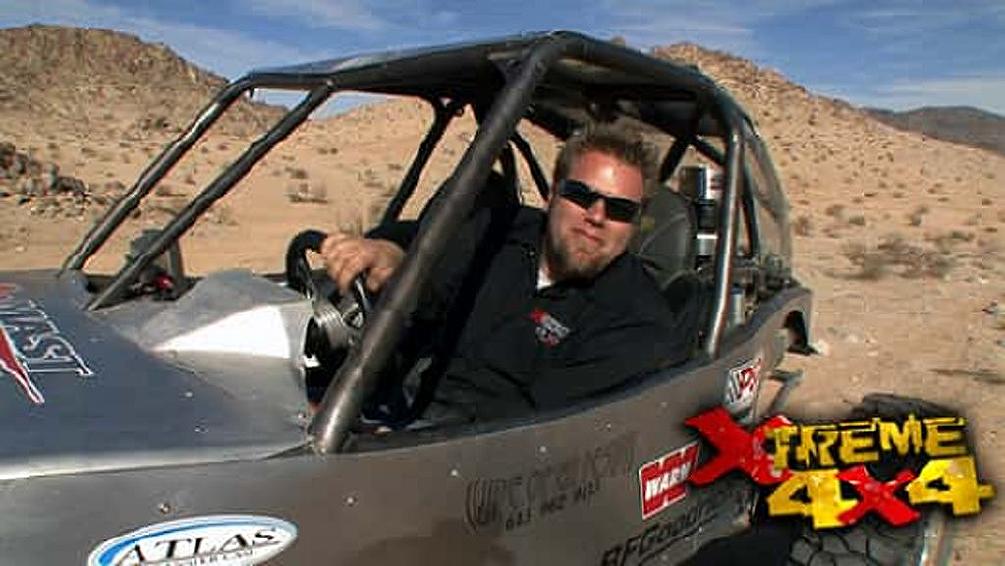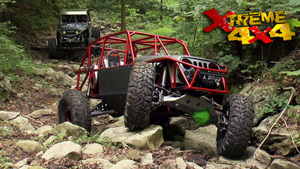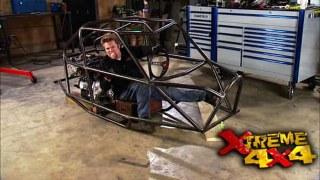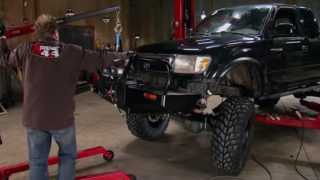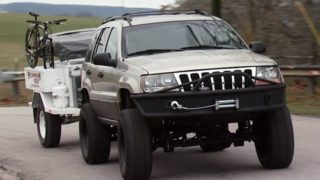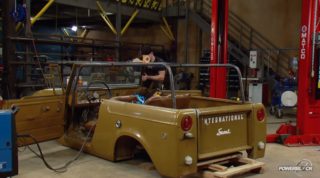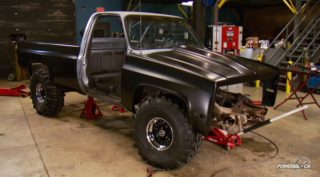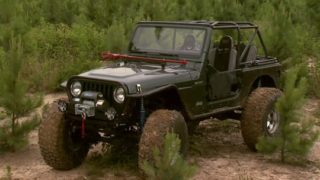More Budget Buggy Episodes
Xtreme 4x4 Builds
Want more content like this?
Join the PowerNation Email NewsletterParts Used In This Episode
QA1
2-Piece - Alloy Steel - Heat Treated Teflon/ Kevlar Self-Lubricating RaceRight & Left Hand Threads.
Ballistic Fabrication
Ballistic Hybrid Coilover/Air Shock.
Ballistic Fabrication
Heavy Duty Ballistic Joint.
Ballistic Fabrication
Laser cut brackets.
Great Lake Off Road, LLC
D.I.Y. Competition Bead Locks.
O'Reilly Auto Parts
Tire Valves Stems
Specialty Products
Flared Hole Dies.
Spidertrax
1.50" thick, 6 on 5.5" 6061-T6 aluminum spacers.
Twisted Stitch,Inc.
The Edge suspension seat comes standard with a fixed headrest, lap belt slots, a sub belt slot and a choice of shoulder belt loops or a shoulder belt slot.
Episode Transcript
What's this PV C over Chroma
Ian sets up a unique free link for our budget buggy. We'll preview our upcoming King of the Hammers special and see what makes this the toughest one day off road course in the world.
Plus beating Russ on a budget.
Recently, we made some changes to the small space underneath our mezzanine. What we'd originally set up as a small two car garage with limited hand tools. We completely changed around, we cleaned everything out and filled it up with some pretty serious fab shop tools to put together a small two car garage fab shop. Now, the downfall
that is we spent all of our money on tools and that left us very little to put into our first project. So we decided to build this small single seat budget buggy. Now, we already have the chassis all put together and we have the drive train mo
in the back. Now, today, we're gonna go ahead and get some junkyard axles underneath this thing and make this thing a roller.
Now, the first step in taking a bear chassis and turning it into a rolling chassis will obviously be setting up the suspension. Now, it can be a fairly daunting task. But if you break it down into each individual step, it's actually not that bad.
The first decision you have to make is how you're gonna set everything up. Are you gonna build it at ride height or full compression? Now, if you're building it, ride height, you basically set your chassis up on some stands, get the belly pan height, maybe 2425 inches off the ground, set your axle on jack stands at half your total time height and build everything from there. Now, in big buggies, you're usually not going to run into any problems, but in small buggies like this building at ride height, you can run into some packaging issues, so it's better to build it at full compression. Now, what that means is we've left the axles on the stands at half the tire height and then we've set the chassis at the height that it's going to be when the suspension is completely bottomed out. That way, we will be able to eliminate any driveline angles or link issues when the suspension is fully compressed.
The first thing we have to do is check the height of all four corners.
The next step is to square up one of the axles to the chassis measuring from a cross bar will set the housing an equal distance on both sides.
Using a center line on the chassis will measure to the ball joints to ensure that the axle is equal on both sides,
then cross measure to make sure that the axle is square. Both of these measurements have to be equal.
The last thing to set is the wheel base. We'll center up the front axle and then measure from the front to the rear
and set ours at 100 and four inches.
Now, there are axles in place. We can start to mock up our suspension. Now, we have to choose what type we're gonna run and on our buggy, we're gonna be running three links with a panhard bar, both front and rear. And the reason for that is because on the right hand side of the buggy, there's very limited space where the center section gets very close to the chassis. So we don't have room for an upper link to make it a four
length. So the three link with the pan hard bar is our best option. Now for link ends, we're going to be using these new ballistic fabrication forge rod ends. Now, they are forged and then machined for the jam nut. And that means that they are heat treated from the shank all the way to the tip. They're fully rebuildable and include the misalignment spacers on the center ball. Now, for the upper links, we have the same ones, they're just a little bit smaller shank for the panhard bar. We'll be using some standard Q A one rod ends just because we don't need the size of the forged joint on that one link end. Now, for brackets, ballistic has just come out with a full laser cut line of brackets. Now, we're going to be modified
these to fit into our buggy. I'm sure you're thinking right now. Well, there's no link material here. What are you gonna use? Well, eventually we're gonna be using 7075 aluminum links on this buggy. So to mock it all in a place we're not gonna use steel. We're gonna use some of this white PV C tubing. Now, the reason that we use this is the whole length of it like this is under three bucks, we can mock everything into place, get the right lens, measure them, send it off to our link builder and we don't have to waste a lot of steel on mock up right now. Gotta clean up the axles
and we built many link suspensions here at extreme. And we always say to you guys, the best thing you can do is have multiple mounting locations for your upper link.
This too buggy, gives us the best opportunity to do that.
Now, when you get done putting this together, call your buddies over to your house and be sure to show them your new lightweight link set up when they're done laughing. Explain it. Simply mock up
to finish up our suspension system. We obviously need some shocks. Now, for our buggy, we chose to use ballistic fabrication's new hybrid shocks. Now, they are a typical air shock with a 14 inch travel and a two inch body and they have all the standard features you'd expect to find an inch and a quarter main shaft valving inside the housing and then a straighter valve at the top to introduce the nitrogen to set the ride height. But the body has been threaded to accept coil over shock springs. Now, this allows us to install some of these small two inch 14 inch travel really lightweight springs
that'll help us out when we're out wheeling and the shock gets a harsh hit. This will help pick up some of that load and the air shock has one drawback is that when it's used a lot off road with cycles and compressions, it actually starts to heat up and it can begin to fade. The springs will eliminate that from happening
after the break to be called the greatest off road driver in the world. You and your rig got to survive five hours and 100 miles of torture.
We're gonna take a look at some of the unique rigs that are built specifically for this race and preview king of the Hammers that's coming up next
king of the Hammers in one word. What would it be?
Awesome?
Incredible
stupid.
Of course,
100 miles of nasty, sharp jagged rocks, round sticky ones, silty hill climb mountain ridges, all this plus wide open high-speed desert stretches. Made king of the Hammers better than Baha.
Is
it everything you dreamed it would be
more,
more. We thought we'd be here in like 10 years. We're here in like 360 days. The race is not only longer,
it's much, much more difficult than last year. Come on.
We knew that guys would have a whole year to build cars last year. We thought if we scare everybody away, they're not gonna wanna come back. So this year, this is the race we originally concept for King of the Hammers
last year was like almost a teaser
to get an idea of what it takes to handle a course like this. We're gonna take a look at three different rigs all with their own unique innovations.
Builder Randy Slosson is a Johnson Valley regular last year. He broke down with a bad power steering pump at mile 25 this year, he's back
with a custom tube chassis built specifically for this race.
One of the things I like about your rig is how clean it is. It just truly is. It's almost like a trail rig. There's not a lot of extra stuff on there. Was that planned from the very beginning or did you sort of end up that way?
I'm all about simple.
The front ends, a hybrid nine inch 60 with a high P nine inch center
got LS one and a 4060 E Atlas four speed and then we got a low opinion Spider nine in the back.
The car has about 20 inches of rear vertical wheel travel and 17 in the front.
It's really eating up the big whoops out here it's just a blast to drive full hydraulic steering front, steer only.
Is there a reason for that
simplicity?
I'm cheap.
Yeah.
Um,
how many, how much, how many degrees front you got out of this thing? About 40 degrees in this type of racing?
A lot of steering angle is not necessary. If you need to steer that sharp, you're going too slow.
Hi, I'm Cotton Rod,
veteran rock racer, Cotton Rod, along with husband Randy formed Jimmy's Outback four by four. This build team created six buggies to run the hammers this year.
But the number seven car with Cotton behind the wheel has some unique frame innovations.
All right, Randy, what did you do different with this specific chassis?
Most of all of our other chassis are pure tube, uh
tubes will wrap around. Uh This, all this will be t right here.
This chassis is different from having the square frame. There's two layers of plate in here. These holes are dimpled holes. A lot of guys call them fast guys holes. Um There's another layer behind here in the holes larger
and there's a weld on each hole anywhere that there's an A pillar B pillar, any type of amount, there's actually a plate inside the frame
to give a strengthening where any of the bars go into that part of the frame.
We went with the two works axle housings here. They're a lot larger, especially wider than most of your conventional axles that allows them to carry more oil for cooling of the ring opinion. We're very confident with this rig. We've increased about 75% overall performance compared to what we brought last year,
Randy
Cotton. Thanks for showing us your rig. Thank you. Best of luck in the race. Guys.
See you.
The underdogs. Here are the east coast guys. Many with no desert experience like our Tennessee buddy, Adam Woodley.
He helped us fabricate our S 10 ruggie.
So wouldn't, you know, as soon as I hit the lake bed, he put me to work.
Do you want me to give you a big shout out because I know everybody in TV. Land just thinks that you like
you come into the show and you're like,
do do, do, do
everybody else finish it. It's true. Let it go.
He and his dad Dwight got two hours of pre running in before they blew the transmission out of his brand new buggy.
And we spent a good portion of last night putting in a spare transmission is great if we hadn't had Ian there the other night to help, put this one bolt in
on
the train.
All kidding aside, this car is impressive. 214 bolt axles, a roll tube chassis, four wheel steer, all aluminum body and these eye catching shock towers. And for the power plant, a
mass motor sports L 76 in the, in the rear to all aluminum 6 L block with VVT, we tucked everything up really high in here, all the training cooler and everything. Because whenever you set in the front seat, you can actually see the whole front axle
five months to build
less than a day to pre
run it.
I'm in love with it.
I just come up with a strategy, I'm gonna run my own race. And whenever I cross the finish line, we'll throw down the cards and see where I end up for Woodley and the other 91 drivers. It's a high stakes poker game with only one winner.
So be sure to tune in next week to Xtreme 4x4 for our King of the Hammers. Special unprecedented coverage of America's most grueling off road race
today. We've made a lot of headway in our small two car garage fab shop. We've put together underneath our mezzanine. We've done a bunch of work on our little budget crawler. We have all the suspension mocked into place and the shocks matter. But before we finish welding anything, we want to get it on some tires and wheels so we can check for any clearance issues. Now, tires for this buggy, we're gonna be using the 42 inch tall pitbull rocker. Now, this is a 42 inch tall tire set up for a 15 inch rim. It has 15 inches of tr
across the cross section and we have run the Rocker on a bunch of our projects. We've been real happy with how they work off road.
The tread pattern has a lot of sharp angles that really tear into the dirt. And because it's a full bias ply tire, it airs down very well and becomes very flexible. And that's how I got a four ply side wall and an integrated rim protector to protect the bolts on the bead lock when you have it aired down. Now, when speaking of bead locks, we obviously got to put one in here for that. It's all budget
making your own bead locks is a great way to save money, especially on a project like this,
using a set of 15 inch steel wheels. We grab from our local junkyard
and a do it yourself. Bead lock kit from Great Lake off Road, we'll have a perfect set of 15 inch steel bead locks.
Once the inner ring is welded to the rim,
the wheel and clamping ring, get a coat of paint,
then the tire can be installed.
Oh, ok.
And a whole lot of balls tightened up.
Now, the final step to any custom suspension build is to bolt on your wheels and tires, flex everything and check for any clearance issues before you finish weld anything into place. Now, we're already pretty sure we may have one problem here and that is, the Yoda axle is just a little bit too narrow than we want it for
this chassis, especially on the rear steer. We're concerned that the tire may contact this lower rail. So we're gonna go ahead and install these spider tracks, wheel spacers to space them out a little bit. They're an inch and a half thick and made out of a anodized aluminum to keep them from rusting. Once we have these mocked in place, we'll go ahead and flex our buggy
just
so by flexing the suspension, we can check everything for any clearance issues. We have lots of room between the shock and the frame on the one side and on the other side where the shock is compressed, there's plenty of room between the tire and the shock. We have no obvious binding on our links. So this suspension is ready to weld in for good
build on a budget Xtreme 4x4 projects that save you time and money.
Now, this truck is a perfect example of what you'll find in a mid-nineties dodge. It has tons of miles on it and it's got a lot of rust at all four corners. Now, this rust right here, it's all the way through from the backside.
Now, there's lots of ways to fix rust like this. You can take it to a body shop and they put a patch panel in and repaint most of the truck you can get a used bed and bolt on as well as two used fenders. Both of those solutions are gonna cost you thousands and thousands of dollars. The solution, we have less than 500 bucks.
We're gonna
cover it up.
Bushwhacker pocket style fender flares are a great solution to this problem and not only hide the rust, but once they're installed, this truck will have a whole new attitude
for a fraction of the price.
Rusty,
all covered up and hidden.
Yeah,
nice
with our suspension mounts all mocked into place and checked. We want to do a couple more things before we tear the chassis down and finish welder. The first is gonna be seat mounts for our new suspension seat and we opted for a twisted stitch edge seat and it's got really sharp lines so it should look really good in our crawler. It has high hip containment to keep us planted and then all the benefits of a suspension seat to absorb that shock when you're out wheeling. And once we get this matted, we're gonna work on some plate work.
Nothing is gonna change the look of this custom chassis more than some custom plate work. Now, you used to only see this kind of stuff on hardcore desert racers, but it's starting to crop up on just everyday trail trucks like this one here and they're not that hard to build. All you gotta do is make a cardboard template
and get your hand on some dimple dice.
Well, there you have it guys, a complete rolling chassis. Now, we still have a few tubes to add and then this thing is ready to be torn down and finished welded. And how much money do we have in it so far? We're still under the $5000 mark for this awesome little rear engine, four wheel steer buggy.
Show Full Transcript
Ian sets up a unique free link for our budget buggy. We'll preview our upcoming King of the Hammers special and see what makes this the toughest one day off road course in the world.
Plus beating Russ on a budget.
Recently, we made some changes to the small space underneath our mezzanine. What we'd originally set up as a small two car garage with limited hand tools. We completely changed around, we cleaned everything out and filled it up with some pretty serious fab shop tools to put together a small two car garage fab shop. Now, the downfall
that is we spent all of our money on tools and that left us very little to put into our first project. So we decided to build this small single seat budget buggy. Now, we already have the chassis all put together and we have the drive train mo
in the back. Now, today, we're gonna go ahead and get some junkyard axles underneath this thing and make this thing a roller.
Now, the first step in taking a bear chassis and turning it into a rolling chassis will obviously be setting up the suspension. Now, it can be a fairly daunting task. But if you break it down into each individual step, it's actually not that bad.
The first decision you have to make is how you're gonna set everything up. Are you gonna build it at ride height or full compression? Now, if you're building it, ride height, you basically set your chassis up on some stands, get the belly pan height, maybe 2425 inches off the ground, set your axle on jack stands at half your total time height and build everything from there. Now, in big buggies, you're usually not going to run into any problems, but in small buggies like this building at ride height, you can run into some packaging issues, so it's better to build it at full compression. Now, what that means is we've left the axles on the stands at half the tire height and then we've set the chassis at the height that it's going to be when the suspension is completely bottomed out. That way, we will be able to eliminate any driveline angles or link issues when the suspension is fully compressed.
The first thing we have to do is check the height of all four corners.
The next step is to square up one of the axles to the chassis measuring from a cross bar will set the housing an equal distance on both sides.
Using a center line on the chassis will measure to the ball joints to ensure that the axle is equal on both sides,
then cross measure to make sure that the axle is square. Both of these measurements have to be equal.
The last thing to set is the wheel base. We'll center up the front axle and then measure from the front to the rear
and set ours at 100 and four inches.
Now, there are axles in place. We can start to mock up our suspension. Now, we have to choose what type we're gonna run and on our buggy, we're gonna be running three links with a panhard bar, both front and rear. And the reason for that is because on the right hand side of the buggy, there's very limited space where the center section gets very close to the chassis. So we don't have room for an upper link to make it a four
length. So the three link with the pan hard bar is our best option. Now for link ends, we're going to be using these new ballistic fabrication forge rod ends. Now, they are forged and then machined for the jam nut. And that means that they are heat treated from the shank all the way to the tip. They're fully rebuildable and include the misalignment spacers on the center ball. Now, for the upper links, we have the same ones, they're just a little bit smaller shank for the panhard bar. We'll be using some standard Q A one rod ends just because we don't need the size of the forged joint on that one link end. Now, for brackets, ballistic has just come out with a full laser cut line of brackets. Now, we're going to be modified
these to fit into our buggy. I'm sure you're thinking right now. Well, there's no link material here. What are you gonna use? Well, eventually we're gonna be using 7075 aluminum links on this buggy. So to mock it all in a place we're not gonna use steel. We're gonna use some of this white PV C tubing. Now, the reason that we use this is the whole length of it like this is under three bucks, we can mock everything into place, get the right lens, measure them, send it off to our link builder and we don't have to waste a lot of steel on mock up right now. Gotta clean up the axles
and we built many link suspensions here at extreme. And we always say to you guys, the best thing you can do is have multiple mounting locations for your upper link.
This too buggy, gives us the best opportunity to do that.
Now, when you get done putting this together, call your buddies over to your house and be sure to show them your new lightweight link set up when they're done laughing. Explain it. Simply mock up
to finish up our suspension system. We obviously need some shocks. Now, for our buggy, we chose to use ballistic fabrication's new hybrid shocks. Now, they are a typical air shock with a 14 inch travel and a two inch body and they have all the standard features you'd expect to find an inch and a quarter main shaft valving inside the housing and then a straighter valve at the top to introduce the nitrogen to set the ride height. But the body has been threaded to accept coil over shock springs. Now, this allows us to install some of these small two inch 14 inch travel really lightweight springs
that'll help us out when we're out wheeling and the shock gets a harsh hit. This will help pick up some of that load and the air shock has one drawback is that when it's used a lot off road with cycles and compressions, it actually starts to heat up and it can begin to fade. The springs will eliminate that from happening
after the break to be called the greatest off road driver in the world. You and your rig got to survive five hours and 100 miles of torture.
We're gonna take a look at some of the unique rigs that are built specifically for this race and preview king of the Hammers that's coming up next
king of the Hammers in one word. What would it be?
Awesome?
Incredible
stupid.
Of course,
100 miles of nasty, sharp jagged rocks, round sticky ones, silty hill climb mountain ridges, all this plus wide open high-speed desert stretches. Made king of the Hammers better than Baha.
Is
it everything you dreamed it would be
more,
more. We thought we'd be here in like 10 years. We're here in like 360 days. The race is not only longer,
it's much, much more difficult than last year. Come on.
We knew that guys would have a whole year to build cars last year. We thought if we scare everybody away, they're not gonna wanna come back. So this year, this is the race we originally concept for King of the Hammers
last year was like almost a teaser
to get an idea of what it takes to handle a course like this. We're gonna take a look at three different rigs all with their own unique innovations.
Builder Randy Slosson is a Johnson Valley regular last year. He broke down with a bad power steering pump at mile 25 this year, he's back
with a custom tube chassis built specifically for this race.
One of the things I like about your rig is how clean it is. It just truly is. It's almost like a trail rig. There's not a lot of extra stuff on there. Was that planned from the very beginning or did you sort of end up that way?
I'm all about simple.
The front ends, a hybrid nine inch 60 with a high P nine inch center
got LS one and a 4060 E Atlas four speed and then we got a low opinion Spider nine in the back.
The car has about 20 inches of rear vertical wheel travel and 17 in the front.
It's really eating up the big whoops out here it's just a blast to drive full hydraulic steering front, steer only.
Is there a reason for that
simplicity?
I'm cheap.
Yeah.
Um,
how many, how much, how many degrees front you got out of this thing? About 40 degrees in this type of racing?
A lot of steering angle is not necessary. If you need to steer that sharp, you're going too slow.
Hi, I'm Cotton Rod,
veteran rock racer, Cotton Rod, along with husband Randy formed Jimmy's Outback four by four. This build team created six buggies to run the hammers this year.
But the number seven car with Cotton behind the wheel has some unique frame innovations.
All right, Randy, what did you do different with this specific chassis?
Most of all of our other chassis are pure tube, uh
tubes will wrap around. Uh This, all this will be t right here.
This chassis is different from having the square frame. There's two layers of plate in here. These holes are dimpled holes. A lot of guys call them fast guys holes. Um There's another layer behind here in the holes larger
and there's a weld on each hole anywhere that there's an A pillar B pillar, any type of amount, there's actually a plate inside the frame
to give a strengthening where any of the bars go into that part of the frame.
We went with the two works axle housings here. They're a lot larger, especially wider than most of your conventional axles that allows them to carry more oil for cooling of the ring opinion. We're very confident with this rig. We've increased about 75% overall performance compared to what we brought last year,
Randy
Cotton. Thanks for showing us your rig. Thank you. Best of luck in the race. Guys.
See you.
The underdogs. Here are the east coast guys. Many with no desert experience like our Tennessee buddy, Adam Woodley.
He helped us fabricate our S 10 ruggie.
So wouldn't, you know, as soon as I hit the lake bed, he put me to work.
Do you want me to give you a big shout out because I know everybody in TV. Land just thinks that you like
you come into the show and you're like,
do do, do, do
everybody else finish it. It's true. Let it go.
He and his dad Dwight got two hours of pre running in before they blew the transmission out of his brand new buggy.
And we spent a good portion of last night putting in a spare transmission is great if we hadn't had Ian there the other night to help, put this one bolt in
on
the train.
All kidding aside, this car is impressive. 214 bolt axles, a roll tube chassis, four wheel steer, all aluminum body and these eye catching shock towers. And for the power plant, a
mass motor sports L 76 in the, in the rear to all aluminum 6 L block with VVT, we tucked everything up really high in here, all the training cooler and everything. Because whenever you set in the front seat, you can actually see the whole front axle
five months to build
less than a day to pre
run it.
I'm in love with it.
I just come up with a strategy, I'm gonna run my own race. And whenever I cross the finish line, we'll throw down the cards and see where I end up for Woodley and the other 91 drivers. It's a high stakes poker game with only one winner.
So be sure to tune in next week to Xtreme 4x4 for our King of the Hammers. Special unprecedented coverage of America's most grueling off road race
today. We've made a lot of headway in our small two car garage fab shop. We've put together underneath our mezzanine. We've done a bunch of work on our little budget crawler. We have all the suspension mocked into place and the shocks matter. But before we finish welding anything, we want to get it on some tires and wheels so we can check for any clearance issues. Now, tires for this buggy, we're gonna be using the 42 inch tall pitbull rocker. Now, this is a 42 inch tall tire set up for a 15 inch rim. It has 15 inches of tr
across the cross section and we have run the Rocker on a bunch of our projects. We've been real happy with how they work off road.
The tread pattern has a lot of sharp angles that really tear into the dirt. And because it's a full bias ply tire, it airs down very well and becomes very flexible. And that's how I got a four ply side wall and an integrated rim protector to protect the bolts on the bead lock when you have it aired down. Now, when speaking of bead locks, we obviously got to put one in here for that. It's all budget
making your own bead locks is a great way to save money, especially on a project like this,
using a set of 15 inch steel wheels. We grab from our local junkyard
and a do it yourself. Bead lock kit from Great Lake off Road, we'll have a perfect set of 15 inch steel bead locks.
Once the inner ring is welded to the rim,
the wheel and clamping ring, get a coat of paint,
then the tire can be installed.
Oh, ok.
And a whole lot of balls tightened up.
Now, the final step to any custom suspension build is to bolt on your wheels and tires, flex everything and check for any clearance issues before you finish weld anything into place. Now, we're already pretty sure we may have one problem here and that is, the Yoda axle is just a little bit too narrow than we want it for
this chassis, especially on the rear steer. We're concerned that the tire may contact this lower rail. So we're gonna go ahead and install these spider tracks, wheel spacers to space them out a little bit. They're an inch and a half thick and made out of a anodized aluminum to keep them from rusting. Once we have these mocked in place, we'll go ahead and flex our buggy
just
so by flexing the suspension, we can check everything for any clearance issues. We have lots of room between the shock and the frame on the one side and on the other side where the shock is compressed, there's plenty of room between the tire and the shock. We have no obvious binding on our links. So this suspension is ready to weld in for good
build on a budget Xtreme 4x4 projects that save you time and money.
Now, this truck is a perfect example of what you'll find in a mid-nineties dodge. It has tons of miles on it and it's got a lot of rust at all four corners. Now, this rust right here, it's all the way through from the backside.
Now, there's lots of ways to fix rust like this. You can take it to a body shop and they put a patch panel in and repaint most of the truck you can get a used bed and bolt on as well as two used fenders. Both of those solutions are gonna cost you thousands and thousands of dollars. The solution, we have less than 500 bucks.
We're gonna
cover it up.
Bushwhacker pocket style fender flares are a great solution to this problem and not only hide the rust, but once they're installed, this truck will have a whole new attitude
for a fraction of the price.
Rusty,
all covered up and hidden.
Yeah,
nice
with our suspension mounts all mocked into place and checked. We want to do a couple more things before we tear the chassis down and finish welder. The first is gonna be seat mounts for our new suspension seat and we opted for a twisted stitch edge seat and it's got really sharp lines so it should look really good in our crawler. It has high hip containment to keep us planted and then all the benefits of a suspension seat to absorb that shock when you're out wheeling. And once we get this matted, we're gonna work on some plate work.
Nothing is gonna change the look of this custom chassis more than some custom plate work. Now, you used to only see this kind of stuff on hardcore desert racers, but it's starting to crop up on just everyday trail trucks like this one here and they're not that hard to build. All you gotta do is make a cardboard template
and get your hand on some dimple dice.
Well, there you have it guys, a complete rolling chassis. Now, we still have a few tubes to add and then this thing is ready to be torn down and finished welded. And how much money do we have in it so far? We're still under the $5000 mark for this awesome little rear engine, four wheel steer buggy.
